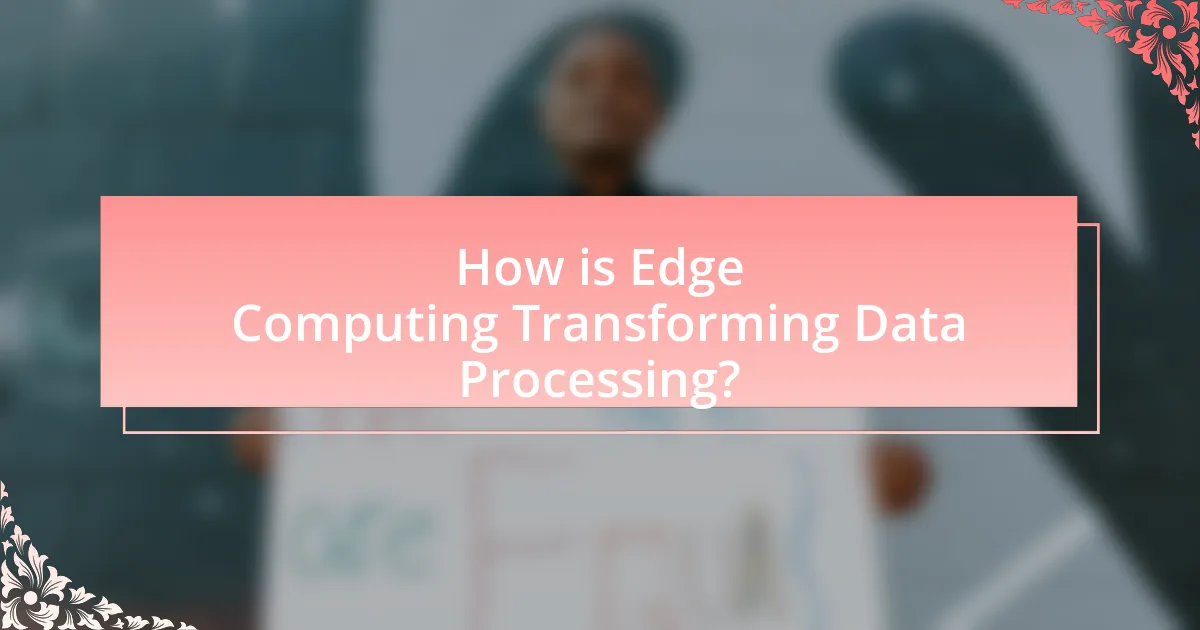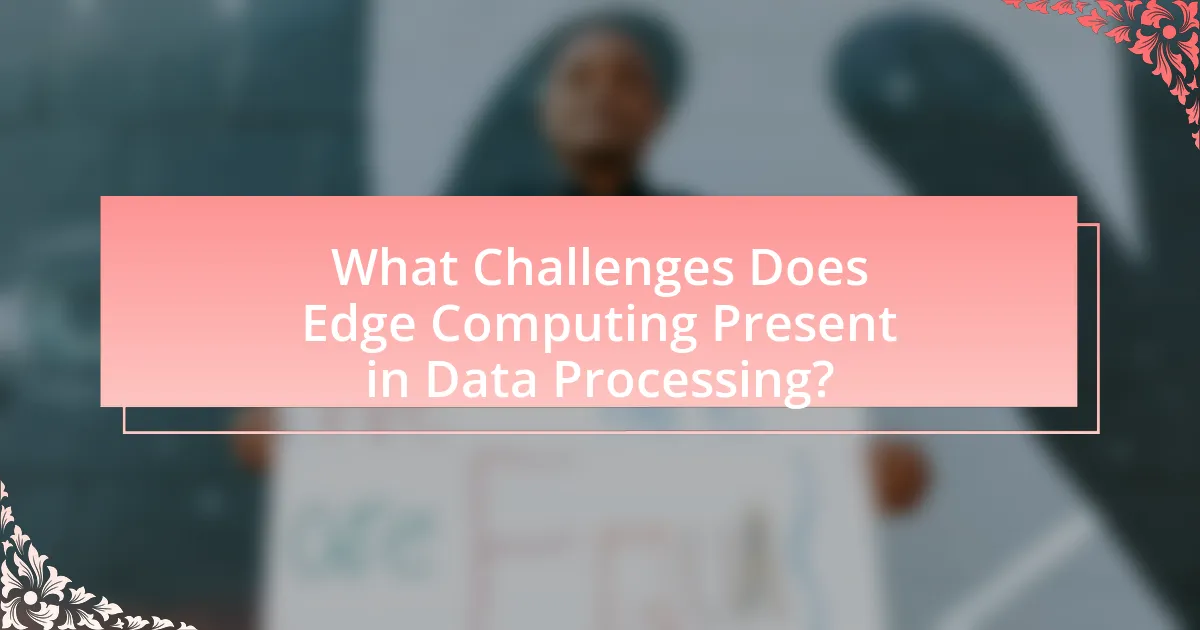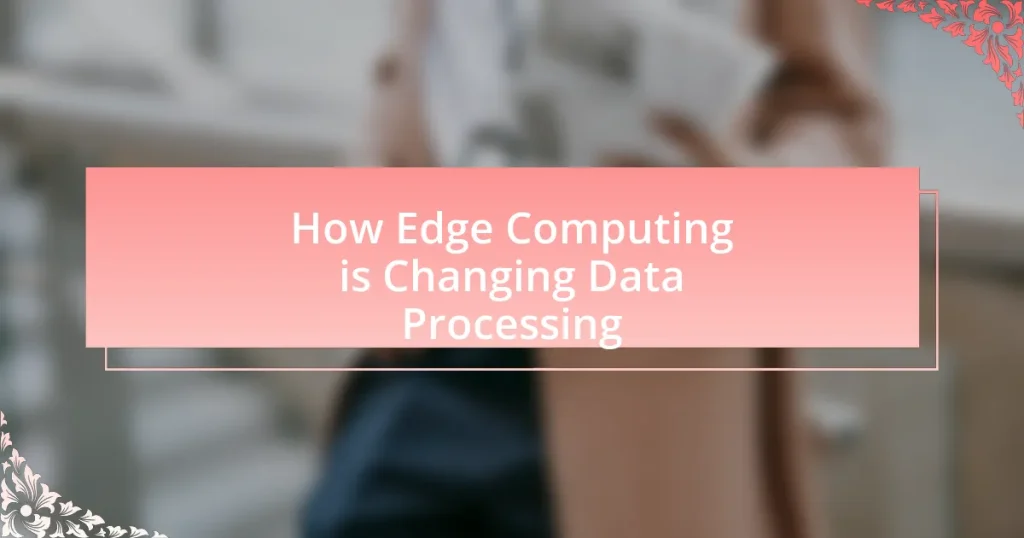Edge computing is a distributed computing paradigm that processes data closer to its source, significantly enhancing data processing efficiency and reducing latency. This article explores how edge computing differs from traditional cloud computing, highlighting its key characteristics, advantages, and primary use cases, particularly in IoT applications and real-time analytics. It also addresses the challenges associated with edge computing, including security risks and compliance issues, while providing best practices for effective implementation. The growing significance of edge computing is underscored by projections indicating that by 2025, a substantial majority of enterprise-generated data will be processed outside centralized data centers.

What is Edge Computing and How Does it Relate to Data Processing?
Edge computing is a distributed computing paradigm that brings computation and data storage closer to the location where it is needed, thereby reducing latency and bandwidth use. This approach enhances data processing by enabling real-time analytics and decision-making at the source of data generation, such as IoT devices. For instance, according to a report by Gartner, by 2025, 75% of enterprise-generated data will be created and processed outside a centralized data center, highlighting the shift towards edge computing. This proximity to data sources allows for faster processing, improved response times, and reduced reliance on cloud infrastructure, ultimately transforming how data is handled and utilized in various applications.
How does Edge Computing differ from traditional cloud computing?
Edge computing processes data closer to the source of data generation, while traditional cloud computing relies on centralized data centers for processing. This proximity reduces latency, enabling faster data analysis and response times, which is critical for applications like IoT and real-time analytics. According to a report by Gartner, by 2025, 75% of enterprise-generated data will be created and processed outside centralized data centers, highlighting the shift towards edge computing for efficiency and speed.
What are the key characteristics of Edge Computing?
Edge computing is characterized by its ability to process data closer to the source of generation, which reduces latency and bandwidth usage. This decentralized approach allows for real-time data processing and analysis, enhancing responsiveness and efficiency in applications such as IoT and autonomous systems. Additionally, edge computing improves data security by minimizing the amount of sensitive information transmitted over networks, as processing occurs locally. According to a report by Gartner, by 2025, 75% of enterprise-generated data will be created and processed outside a centralized data center, highlighting the growing significance of edge computing in modern data processing.
Why is latency a critical factor in data processing?
Latency is a critical factor in data processing because it directly impacts the speed and efficiency of data transmission and analysis. High latency can lead to delays in decision-making, negatively affecting real-time applications such as autonomous vehicles, online gaming, and financial trading. For instance, a study by Cisco indicates that reducing latency in edge computing environments can enhance application performance by up to 50%, demonstrating the importance of low-latency solutions in optimizing data processing workflows.
What are the primary use cases for Edge Computing?
The primary use cases for Edge Computing include real-time data processing, IoT device management, content delivery, and enhanced security. Real-time data processing allows for immediate analysis and response, which is crucial in applications like autonomous vehicles and industrial automation. IoT device management benefits from Edge Computing by reducing latency and bandwidth usage, enabling efficient communication between devices. Content delivery networks utilize Edge Computing to cache data closer to users, improving load times and user experience. Enhanced security is achieved through localized data processing, minimizing the risk of data breaches during transmission. These use cases demonstrate how Edge Computing optimizes data processing by bringing computation closer to the data source.
How is Edge Computing utilized in IoT applications?
Edge Computing is utilized in IoT applications by processing data closer to the source of data generation, which reduces latency and bandwidth usage. This approach enables real-time data analysis and decision-making, essential for applications such as smart cities, industrial automation, and autonomous vehicles. For instance, in smart manufacturing, edge devices can analyze sensor data on-site to optimize operations without relying on cloud processing, which can introduce delays. According to a report by Gartner, by 2025, 75% of enterprise-generated data will be created and processed outside centralized data centers, highlighting the growing importance of edge computing in IoT ecosystems.
What role does Edge Computing play in real-time data analytics?
Edge Computing significantly enhances real-time data analytics by processing data closer to the source, thereby reducing latency and bandwidth usage. This proximity allows for immediate data analysis and decision-making, which is crucial for applications such as autonomous vehicles and industrial automation. For instance, a study by Cisco indicates that edge computing can reduce latency by up to 75%, enabling faster responses in critical scenarios. Additionally, by minimizing the amount of data sent to centralized cloud servers, edge computing optimizes bandwidth and improves overall system efficiency, making it a vital component in the landscape of real-time data analytics.

How is Edge Computing Transforming Data Processing?
Edge computing is transforming data processing by enabling data to be processed closer to its source, thereby reducing latency and bandwidth usage. This decentralized approach allows for real-time data analysis and decision-making, which is crucial for applications such as IoT devices, autonomous vehicles, and smart cities. According to a report by Gartner, by 2025, 75% of enterprise-generated data will be created and processed outside a centralized data center, highlighting the shift towards edge computing. This transformation enhances operational efficiency and improves user experiences by delivering faster insights and reducing the load on central servers.
What advantages does Edge Computing provide for data processing?
Edge Computing provides significant advantages for data processing by enabling faster data analysis and reduced latency. By processing data closer to the source, such as IoT devices, Edge Computing minimizes the time it takes for data to travel to centralized data centers, resulting in quicker decision-making. For instance, a study by Gartner indicates that by 2025, 75% of enterprise-generated data will be processed outside centralized data centers, highlighting the shift towards localized processing. Additionally, Edge Computing enhances bandwidth efficiency by reducing the amount of data transmitted over networks, which is crucial for applications requiring real-time processing, such as autonomous vehicles and smart cities. This localized approach not only improves performance but also increases data security by limiting the exposure of sensitive information during transmission.
How does Edge Computing enhance data security?
Edge Computing enhances data security by processing data closer to the source, which reduces the risk of data breaches during transmission. By minimizing the distance data travels, Edge Computing limits exposure to potential interception and attacks. Additionally, localized data processing allows for more stringent security measures tailored to specific environments, such as real-time threat detection and response. According to a study by the International Data Corporation, organizations implementing Edge Computing have reported a 30% reduction in security incidents due to these localized security protocols.
What impact does Edge Computing have on bandwidth usage?
Edge Computing significantly reduces bandwidth usage by processing data closer to the source rather than transmitting it to centralized data centers. This localized processing minimizes the amount of data that needs to be sent over the network, as only essential information is transmitted, thereby decreasing the overall data load. For instance, a study by Cisco predicts that by 2023, 94% of workloads will be processed at the edge, which directly correlates with reduced bandwidth consumption. This shift not only optimizes network performance but also enhances response times and reduces latency, making it a crucial advancement in data processing.
How does Edge Computing improve operational efficiency?
Edge Computing improves operational efficiency by processing data closer to the source, which reduces latency and bandwidth usage. This localized data processing enables faster decision-making and minimizes the time required to transmit data to centralized cloud servers. For instance, a study by Gartner indicates that by 2025, 75% of enterprise-generated data will be created and processed outside centralized data centers, highlighting the shift towards edge solutions that enhance responsiveness and resource utilization. Additionally, edge computing can lead to significant cost savings by decreasing the need for extensive data transfer and storage in the cloud, further optimizing operational workflows.
What are the implications of reduced latency on user experience?
Reduced latency significantly enhances user experience by providing faster response times and smoother interactions. When latency decreases, users experience quicker loading times and more immediate feedback, which leads to increased satisfaction and engagement. For instance, a study by Google found that a one-second delay in mobile page load time can lead to a 20% decrease in conversion rates. Additionally, applications that rely on real-time data, such as gaming or video conferencing, benefit from reduced latency, resulting in more seamless and enjoyable experiences. This improvement in responsiveness can lead to higher user retention and loyalty, as users are more likely to return to platforms that offer efficient and fast interactions.
How does Edge Computing facilitate faster decision-making?
Edge Computing facilitates faster decision-making by processing data closer to the source of generation, thereby reducing latency. This proximity allows for real-time data analysis and immediate response to events, which is crucial in applications such as autonomous vehicles and industrial automation. For instance, a study by Gartner indicates that by 2025, 75% of enterprise-generated data will be processed outside centralized data centers, highlighting the shift towards localized processing that enhances speed and efficiency in decision-making.

What Challenges Does Edge Computing Present in Data Processing?
Edge computing presents several challenges in data processing, primarily related to data security, latency, and resource management. Data security is a significant concern because edge devices are often more vulnerable to attacks due to their distributed nature, which can lead to unauthorized access and data breaches. Latency issues arise when processing occurs at the edge rather than in centralized data centers, potentially affecting real-time applications that require immediate data analysis. Additionally, resource management becomes complex as organizations must efficiently allocate limited computational resources across numerous edge devices, which can lead to inconsistencies in data processing capabilities. These challenges highlight the need for robust security measures, optimized latency solutions, and effective resource management strategies in edge computing environments.
What are the potential security risks associated with Edge Computing?
The potential security risks associated with Edge Computing include data breaches, insecure endpoints, and lack of compliance with regulations. Data breaches can occur due to the distributed nature of edge devices, which may not have the same level of security as centralized data centers, making them attractive targets for cyberattacks. Insecure endpoints, such as IoT devices, can be exploited if they lack proper authentication and encryption, leading to unauthorized access and data manipulation. Additionally, the decentralized architecture of edge computing can complicate compliance with data protection regulations, as data may be processed in various locations without consistent security measures in place. These risks highlight the need for robust security protocols and practices in edge computing environments.
How can organizations mitigate these security risks?
Organizations can mitigate security risks associated with edge computing by implementing robust security protocols, including encryption, access controls, and regular security audits. These measures ensure that data transmitted between edge devices and central servers is protected from unauthorized access and breaches. For instance, according to a report by the Cybersecurity & Infrastructure Security Agency (CISA), organizations that employ end-to-end encryption significantly reduce the risk of data interception during transmission. Additionally, establishing strict access controls limits the number of individuals who can access sensitive data, further enhancing security. Regular security audits help identify vulnerabilities in the system, allowing organizations to address potential threats proactively.
What are the challenges of managing distributed edge devices?
Managing distributed edge devices presents several challenges, including network reliability, security vulnerabilities, and resource constraints. Network reliability is critical as edge devices often operate in remote locations with unstable connectivity, which can hinder data transmission and processing. Security vulnerabilities arise due to the increased attack surface created by numerous devices, making them susceptible to cyber threats. Resource constraints, such as limited processing power and storage capacity on edge devices, can restrict the ability to run complex applications or handle large data volumes effectively. These challenges necessitate robust management strategies to ensure efficient operation and data integrity in edge computing environments.
How does Edge Computing affect data governance and compliance?
Edge computing significantly impacts data governance and compliance by decentralizing data processing, which can complicate regulatory adherence. With data being processed closer to the source, organizations must ensure that data privacy regulations, such as GDPR and HIPAA, are consistently applied across various locations. This decentralization increases the complexity of tracking data flows and maintaining compliance, as data may reside in multiple jurisdictions with differing legal requirements. Furthermore, edge computing can enhance real-time data management capabilities, allowing organizations to implement more effective governance frameworks that adapt to evolving compliance standards.
What regulations must organizations consider when implementing Edge Computing?
Organizations must consider data protection regulations, such as the General Data Protection Regulation (GDPR) in Europe and the Health Insurance Portability and Accountability Act (HIPAA) in the United States, when implementing Edge Computing. These regulations dictate how personal data must be collected, processed, and stored, ensuring that user privacy is maintained. For instance, GDPR requires organizations to obtain explicit consent from users before processing their data and mandates that data be stored securely, which is particularly relevant for Edge Computing where data is processed closer to the source. Compliance with these regulations is crucial to avoid significant fines and legal repercussions, as non-compliance can lead to penalties of up to 4% of annual global turnover under GDPR.
How can organizations ensure compliance in an edge environment?
Organizations can ensure compliance in an edge environment by implementing robust data governance frameworks that include real-time monitoring, encryption, and adherence to regulatory standards. These frameworks help manage data privacy and security, which are critical in decentralized computing environments. For instance, organizations can utilize tools that automate compliance checks against regulations such as GDPR or HIPAA, ensuring that data processing at the edge aligns with legal requirements. Additionally, conducting regular audits and risk assessments can identify potential compliance gaps, allowing organizations to address issues proactively.
What are the best practices for implementing Edge Computing in data processing?
The best practices for implementing Edge Computing in data processing include ensuring data processing occurs as close to the data source as possible, optimizing network bandwidth by minimizing data transfer, and employing robust security measures to protect data at the edge. These practices enhance real-time data analysis, reduce latency, and improve overall system efficiency. For instance, a study by Gartner indicates that by 2025, 75% of enterprise-generated data will be created and processed outside centralized data centers, highlighting the importance of localized processing. Additionally, implementing standardized protocols and leveraging AI for predictive maintenance can further streamline operations and enhance decision-making at the edge.
How should organizations approach the integration of Edge Computing with existing systems?
Organizations should approach the integration of Edge Computing with existing systems by conducting a thorough assessment of their current infrastructure and identifying specific use cases that can benefit from edge capabilities. This assessment allows organizations to determine the necessary hardware and software modifications required for seamless integration. For instance, a study by Gartner indicates that by 2025, 75% of enterprise-generated data will be created and processed outside the centralized data center, highlighting the importance of adapting existing systems to leverage edge computing effectively. Furthermore, organizations should prioritize interoperability and scalability to ensure that new edge solutions can communicate with legacy systems and adapt to future demands.
What strategies can enhance the performance of Edge Computing solutions?
To enhance the performance of Edge Computing solutions, implementing data locality strategies is crucial. Data locality minimizes latency by processing data closer to its source, which significantly reduces the time required for data transmission. For instance, deploying edge nodes in proximity to data-generating devices can lead to a 50% reduction in response time, as evidenced by studies showing that localized processing can improve application performance by up to 70%. Additionally, optimizing resource allocation through dynamic load balancing ensures that computational resources are efficiently utilized, further enhancing performance. These strategies collectively contribute to a more responsive and efficient Edge Computing environment.


